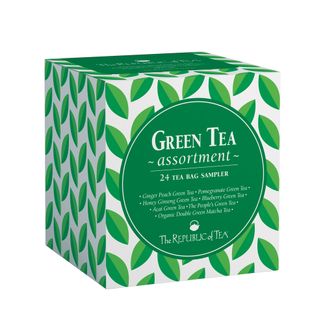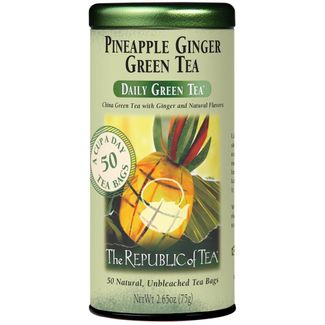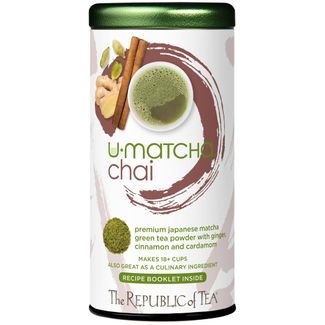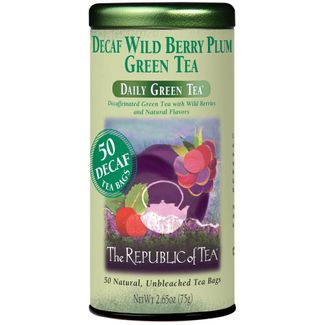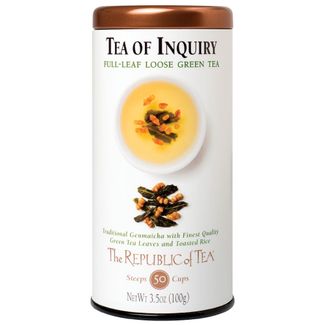Green Tea

What is Green Tea?
Green tea is a type of tea derived from the tea plant, Camellia sinensis. Other types of tea such as black, oolong and white tea are also made using the leaves of the Camellia sinensis plant. Why then does green tea look, smell and taste so different from these other varietals?
Although all “true” teas are derived from the same plant, their post-harvest processing methods differ. After green tea is harvested, it undergoes a three-stage process of steaming or pan-frying, rolling and firing. Heating the leaves (through steaming or pan-frying) halts oxidation, allowing the tea leaves to retain their green coloring, mild vegetal flavors and high concentration of antioxidants.
Green tea is an ancient beverage that has been sipped for thousands of years. It is revered for its myriad of health benefits as well as its pleasant taste and soothing aroma.
Green Tea Bags vs. Loose Leaf Green Tea
You can buy premium green tea in two primary forms: green tea bags and full-leaf loose green tea leaves. Both offer unique benefits depending on the preferences of the tea drinker.
Steeping a tea bag is quick and easy. You don’t need any special equipment, and it is even possible to make green tea on-the-go as long as you have access to a mug and heated water.
Full-leaf green tea does require the use of an infuser basket or strainer, but many tea drinkers prefer the experience of sipping loose leaf tea. Indeed, it can be a meditative experience watching as the leaves unfurl in the water, releasing their full flavors and health benefits.
What Does Green Tea Taste Like?
Humans have been drinking green tea for thousands of years. Among many other reasons, one of the primary factors behind the lasting popularity of this beverage is its wonderful flavor. Generally speaking, green tea has a clean, gentle vegetal or grassy taste. Depending on the exact varietal you are sipping, the tasting notes may include floral, nutty, herbaceous, sweet or earthy flavors and aromas. The taste of green tea can also vary from cup to cup depending on the steeping method used.
Types of Green Tea
Green tea is a broad category that includes many unique varietals. For a classic green tea sipping experience, you cannot go wrong with a pure green tea such as The People’s Green Tea or Organic Dancing Leaves Green Tea. That said, the delicate grassy flavor of green tea also pairs beautifully with many other herbs, botanicals, fruits, spices and other flavors, yielding vibrant blends that will surprise and delight.
Several of our best-selling flavored green tea bags include Ginger Peach Green Tea, Organic Turmeric Ginger Green Tea, Organic Serenity SuperGreen Tea, Spring Cherry Green Tea and Organic Jasmine Green Tea. There are dozens of premium varietals in The Republic of Tea's expansive green tea collection. All tea drinkers have their own flavor preferences, so we always recommend experimenting with different varietals and blends to see which ones you love best.
Several of our best-selling green teas are also available as decaffeinated green teas. The Republic of Tea is proud to be one of the world's top green tea brands, stocking a wide variety of innovative green teas to suit every taste.
Caffeine Content in Green Tea
Wondering whether you should swap out your morning cup of coffee for a cup of all natural green tea instead? Green tea does contain caffeine, albeit a lesser amount than many other popular caffeinated beverages, such as coffee and black tea. A standard 8 oz cup of green tea usually contains between 20-50 mg of caffeine. By comparison, a similarly-sized cup of coffee contains anywhere from 100-200 mg of caffeine. Black teas usually contain around 60-80 mg.
It is important to note that the amount of caffeine in green tea can vary depending on several factors, such as the steeping time, the temperature of the water used to steep the tea and the specific varietal of green tea being steeped.
A unique quality of green tea compared to coffee and energy drinks — which are often accompanied by unwanted side effects like jitters and headaches — is that it contains the amino acid L-theanine. This beneficial compound may positively affect alertness, focus, memory and mood, especially in conjunction with caffeine.
All of that to say, if you are looking to reduce your coffee consumption or are tired of dealing with the effects of too much caffeine, swapping out your morning cup of coffee for green tea might be an excellent idea. Learn more here: Does Green Tea Have Caffeine?
How To Steep Green Tea
In order to experience all the delicious benefits of green tea, it is important to start with high quality green tea leaves or green tea bags. Yet equally important is the art of steeping. Water quality and temperature, steeping time and the ratio of tea to water can all have an impact on green tea's taste and quality.
In general, you should steep green tea anywhere from one to four minutes. The exact timing will depend on the type of green tea, whether you are using loose leaves or a tea bag, and your own preferences. Learn more here: How Long Do I Steep Green Tea?
FAQ
When should I drink green tea?
In many parts of the world, green tea is sipped all day long. A freshly steeped cup of green tea is a healthful way to begin your morning, or to boost your mood and focus during an afternoon slump. While some people enjoy drinking green tea in the evening, it is important to be mindful of the fact that green tea does contain caffeine. You may prefer to limit your green tea consumption before bed to reduce the risk of difficulties sleeping, and switch to an herbal tea in the evening instead.
What are the health benefits of green tea?
Curious about the health benefits of drinking green tea? Green tea may offer many possible health benefits. It is rich in a type of antioxidant known as polyphenols, which are believed to help fight inflammation and reduce the risk of many chronic illnesses (source). Drinking green tea may lower blood sugar levels (source) as well as high blood pressure (source). Additionally, consuming green tea is associated with a reduced risk of cardiovascular disease (source).
Green tea consumption has also been associated with weight loss (source). In fact, green tea supplements containing green tea extract have become very popular in the wellness industry for this reason. And as mentioned above, green tea contains the amino acid L-theanine, which may positively affect cognition. Green tea benefits on health are still being studied, so it is always recommended to speak with your doctor about any specific wellness concerns or goals.
Learn more here: 3 Reasons Green Tea is a Daily Must Drink
How to store green tea?
Proper storage is key to maintaining the quality, flavor, aromas and health benefits of green tea. For easy and convenient storage, we recommend keeping your tea in its original The Republic of Tea packaging. Our airtight steel tins were designed to keep out external odors, sunlight, moisture and other contaminants. It is also important to keep your tea away from heat emitting appliances such as the oven or dishwasher. Learn more here: Tips for Storing Tea
How to make iced green tea?
Think you can only drink green tea on a chilly day? Think again! While we love starting every morning with a hot cup of green tea, iced beverages can be more thirst-quenching on a sweltering summer day. Fortunately, green tea tastes just as incredible on ice as it does hot. You can make iced tea using pure green tea leaves, or blends featuring other fruits, herbs and spices. Learn more here: How to Steep Iced Tea
Is green tea hydrating?
Have you heard that drinking green tea is hydrating? It’s true! That’s because when you drink a cup of green tea, you are contributing to your daily water intake. While you certainly shouldn’t replace all of your water consumption with tea, drinking tea does help to hydrate your body and offers similar hydrating benefits to drinking water. A win-win for tea lovers.



























